Evaluative Potential for Reclaimed Mine Soils Under Four Revegetation Types Using Integrated Soil Quality Index and PLS-SEM
Abstract
1. Introduction
2. Materials and Methods
2.1. Study Area
2.2. Sampling Plots Design and Vegetation Surveys
2.3. Soil Sampling and Analysis
2.4. Calculations of SOC and TN Stocks
2.5. Calculation of Integrated Soil Quality Index
2.6. Statistical Analysis
3. Results
3.1. Soil Physicochemical Properties in Reclaimed Sites
3.2. SOC and TN Stocks in Reclaimed Sites
3.3. ISQI and PLS-SEM Analysis
4. Discussion
4.1. Effect of Revegetation in Mine Restoration Areas
4.2. Accretion of SOC and TN Stocks
4.3. Evaluation of Soil Quality Based on ISQI Approach
5. Conclusions
Supplementary Materials
Author Contributions
Funding
Institutional Review Board Statement
Informed Consent Statement
Data Availability Statement
Conflicts of Interest
References
- Chi, M.; Zhang, D.; Zhao, Q.; Yu, W.; Liang, S. Determining the Scale of Coal Mining in an Ecologically Fragile Mining Area under the Constraint of Water Resources Carrying Capacity. J. Environ. Manag. 2021, 279, 111621. [Google Scholar] [CrossRef]
- Ličina, V.; Akšić, M.F.; Tomić, Z.; Trajković, I.; Antić Mladenović, S.; Marjanović, M.; Rinklebe, J. Bioassessment of Heavy Metals in the Surface Soil Layer of an Opencast Mine Aimed for Its Rehabilitation. J. Environ. Manag. 2017, 186, 240–252. [Google Scholar] [CrossRef] [PubMed]
- Zhang, H.; Chu, L.M. Plant Community Structure, Soil Properties and Microbial Characteristics in Revegetated Quarries. Ecol. Eng. 2011, 37, 1104–1111. [Google Scholar] [CrossRef]
- Macdonald, S.E.; Landhäusser, S.M.; Skousen, J.; Franklin, J.; Frouz, J.; Hall, S.; Jacobs, D.F.; Quideau, S. Forest Restoration Following Surface Mining Disturbance: Challenges and Solutions. New For. 2015, 46, 703–732. [Google Scholar] [CrossRef]
- Zhao, W.; Zhang, R.; Huang, C.; Wang, B.; Cao, H.; Koopal, L.K.; Tan, W. Effect of Different Vegetation Cover on the Vertical Distribution of Soil Organic and Inorganic Carbon in the Zhifanggou Watershed on the Loess Plateau. CATENA 2016, 139, 191–198. [Google Scholar] [CrossRef]
- Feng, Y.; Wang, J.; Bai, Z.; Reading, L. Effects of Surface Coal Mining and Land Reclamation on Soil Properties: A Review. Earth-Sci. Rev. 2019, 191, 12–25. [Google Scholar] [CrossRef]
- van Breemen, N. Soils as Biotic Constructs Favouring Net Primary Productivity. Geoderma 1993, 57, 183–211. [Google Scholar] [CrossRef]
- Zhu, T.; Li, C.; Liu, X.; Zhao, X. Assessing Ecological Restoration in Arid Mining Regions: A Progressive Evaluation System. Sustainability 2024, 16, 2266. [Google Scholar] [CrossRef]
- Zhang, P.P.; Zhang, Y.L.; Jia, J.C.; Cui, Y.X.; Wang, X.; Zhang, X.C.; Wang, Y.Q. Revegetation Pattern Affecting Accumulation of Organic Carbon and Total Nitrogen in Reclaimed Mine Soils. PeerJ 2020, 8, e8563. [Google Scholar] [CrossRef] [PubMed]
- Lehmann, A. Technosols and Other Proposals on Urban Soils for the WRB (World Reference Base for Soil Resources). Int. Agrophys. 2006, 20, 129–134. [Google Scholar]
- Doran, J.W.; Coleman, D.C.; Bezdicek, D.F.; Stewart, B.A.; Haynes, R.J. (Eds.) Defining Soil Quality for a Sustainable Environment; SSSA, American Society of Agronomy: Madison, WI, USA, 1995; ISBN 978-0-89118-807-0. [Google Scholar]
- Robertson, W.J.; Kinnunen, P.H.-M.; Plumb, J.J.; Franzmann, P.D.; Puhakka, J.A.; Gibson, J.A.E.; Nichols, P.D. Moderately Thermophilic Iron Oxidising Bacteria Isolated from a Pyritic Coal Deposit Showing Spontaneous Combustion. Miner. Eng. 2002, 15, 815–822. [Google Scholar] [CrossRef]
- Dang, J.H. Problems and challenges of ecological environment in coal mine areas of Shanxi. China Coal 2021, 47, 117–121. [Google Scholar] [CrossRef]
- Mi, J.; Liu, R.; Zhang, S.; Hou, H.; Yang, Y.; Chen, F.; Zhang, L. Vegetation Patterns on a Landslide after Five Years of Natural Restoration in the Loess Plateau Mining Area in China. Ecol. Eng. 2019, 136, 46–54. [Google Scholar] [CrossRef]
- Wong, M.H. Ecological Restoration of Mine Degraded Soils, with Emphasis on Metal Contaminated Soils. Chemosphere 2003, 50, 775–780. [Google Scholar] [CrossRef]
- Yuan, Y.; Zhao, Z.; Zhang, P.; Chen, L.; Hu, T.; Niu, S.; Bai, Z. Soil Organic Carbon and Nitrogen Pools in Reclaimed Mine Soils under Forest and Cropland Ecosystems in the Loess Plateau, China. Ecol. Eng. 2017, 102, 137–144. [Google Scholar] [CrossRef]
- Misebo, A.M.; Pietrzykowski, M.; Woś, B. Soil Carbon Sequestration in Novel Ecosystems at Post-Mine Sites—A New Insight into the Determination of Key Factors in the Restoration of Terrestrial Ecosystems. Forests 2022, 13, 63. [Google Scholar] [CrossRef]
- Forrester, I.D.; Bauhus, J. A Review of Processes Behind Diversity—Productivity Relationships in Forests. Curr. For. Rep. 2016, 2, 45–61. [Google Scholar] [CrossRef]
- Lisetskii, F.N.; Buryak, Z.A.; Marinina, O.A.; Ukrainskiy, P.A.; Goleusov, P.V. Features of Soil Organic Carbon Transformations in the Southern Area of the East European Plain. Geosciences 2023, 13, 278. [Google Scholar] [CrossRef]
- Xu, H.; Xu, F.; Lin, T.; Xu, Q.; Yu, P.; Wang, C.; Aili, A.; Zhao, X.; Zhao, W.; Zhang, P.; et al. A Systematic Review and Comprehensive Analysis on Ecological Restoration of Mining Areas in the Arid Region of China: Challenge, Capability and Reconsideration. Ecol. Indic. 2023, 154, 110630. [Google Scholar] [CrossRef]
- Jang, C.-S.; Chen, S.-K.; Ching-Chieh, L. Using Multiple-Variable Indicator Kriging to Assess Groundwater Quality for Irrigation in the Aquifers of the Choushui River Alluvial Fan. Hydrol. Process. 2008, 22, 4477–4489. [Google Scholar] [CrossRef]
- Mutuku, E.A.; Vanlauwe, B.; Roobroeck, D.; Boeckx, P.; Cornelis, W.M. Visual Soil Examination and Evaluation in the Sub-Humid and Semi-Arid Regions of Kenya. Soil Tillage Res. 2021, 213, 105135. [Google Scholar] [CrossRef]
- An, Y.; Zhang, L.; Wang, Q.; Han, Y. Soil Quality Assessment of Different Land Use Types Based on TOPSIS Method in Hilly Sandy Area of Loess Plateau, Northern China. Int. J. Environ. Res. Public Health 2022, 19, 17059. [Google Scholar] [CrossRef] [PubMed]
- Wang, G.; Dong, Y.; Rong, L.; Yang, W.; Duan, X. The Influence of Vegetation Restoration on Soil Quality in Abandoned Farmlands in the Yuanjiang Dry-Hot Valley. CATENA 2024, 242, 108109. [Google Scholar] [CrossRef]
- Bandyopadhyay, S.; Novo, L.A.B.; Pietrzykowski, M.; Maiti, S.K. Assessment of Forest Ecosystem Development in Coal Mine Degraded Land by Using Integrated Mine Soil Quality Index (IMSQI): The Evidence from India. Forests 2020, 11, 1310. [Google Scholar] [CrossRef]
- Chen, S.; Wu, S.; Yang, J. Forest Management Has a Mixed Effect on Understory Biomass, but Understory Species Diversity and Stand Structure Are Key. Eur. J. For. Res. 2025, 144, 255–265. [Google Scholar] [CrossRef]
- Hair, J.F.; Risher, J.J.; Sarstedt, M.; Ringle, C.M. When to Use and How to Report the Results of PLS-SEM. Eur. Bus. Rev. 2019, 31, 2–24. [Google Scholar] [CrossRef]
- Ketchen, D.J. A Primer on Partial Least Squares Structural Equation Modeling. Long Range Plan. 2013, 46, 184–185. [Google Scholar] [CrossRef]
- Dong, L.; Hua, Y.; Gao, Z.; Wu, H.; Hou, Y.; Chu, Y.; Zhang, J.; Cui, G. The Multiple Promoting Effects of Suaeda Glauca Root Exudates on the Growth of Alfalfa under NaCl Stress. Plants 2024, 13, 752. [Google Scholar] [CrossRef]
- Komba, B.P.; Chattha, M.W.A.; Fatima, A.; Thomson, P.C.; González, L.A.; Hyder, M.F. Assessing the Environmental, Economic, and Social Impacts of Industrial Mining on Agricultural Communities in Sierra Leone: A Sustainable Approach Using PLS-SEM. Clean. Responsible Consum. 2025, 16, 100250. [Google Scholar] [CrossRef]
- Zhu, H.; Tong, G.; Duan, N.; Ma, H.; Song, Q.; Wang, J.; Luo, Y.; Zhang, Q.; Yu, X.; Jin, S. Analysis of the Complex Correlations between Land Use and Water Quality Using the PLS-SEM Method Combined with Fluorescence Fingerprinting Data. J. Environ. Manag. 2025, 373, 123688. [Google Scholar] [CrossRef]
- Bradshaw, A. The Use of Natural Processes in Reclamation—Advantages and Difficulties. Landsc. Urban Plan. 2000, 51, 89–100. [Google Scholar] [CrossRef]
- Yan, M.; Fan, L.; Wang, L. Restoration of Soil Carbon with Different Tree Species in a Post-Mining Land in Eastern Loess Plateau, China. Ecol. Eng. 2020, 158, 106025. [Google Scholar] [CrossRef]
- Chen, J.; Jiskani, I.M.; Li, G. Ecological Restoration of Coalmine-Degraded Lands: Influence of Plant Species and Revegetation on Soil Development. Sustainability 2023, 15, 13772. [Google Scholar] [CrossRef]
- Ringle, C.M.; Wende, S.; Becker, J.-M. SmartPLS 4; SmartPLS GmbH: Bönningstedt, Germany, 2024. [Google Scholar]
- Brown, S.; DeVolder, P.; Compton, H.; Henry, C. Effect of Amendment C:N Ratio on Plant Richness, Cover and Metal Content for Acidic Pb and Zn Mine Tailings in Leadville, Colorado. Environ. Pollut. 2007, 149, 165–172. [Google Scholar] [CrossRef] [PubMed]
- Zhang, Y.; Mai, H.; Qiu, Q.; Zhu, Y.; Long, J.; Chen, S.; Chen, Y. The Responses of C, N, P and Stoichiometric Ratios to Biochar and Vermicompost Additions Differ from Alfalfa and a Mine Soil. Agriculture 2023, 13, 1954. [Google Scholar] [CrossRef]
- Zhao, Z.; Shahrour, I.; Bai, Z.; Fan, W.; Feng, L.; Li, H. Soils Development in Opencast Coal Mine Spoils Reclaimed for 1–13 Years in the West-Northern Loess Plateau of China. Eur. J. Soil Biol. 2013, 55, 40–46. [Google Scholar] [CrossRef]
- Li, N.; Skaggs, T.H.; Ellegaard, P.; Bernal, A.; Scudiero, E. Relationships among Soil Moisture at Various Depths under Diverse Climate, Land Cover and Soil Texture. Sci. Total Environ. 2024, 947, 174583. [Google Scholar] [CrossRef]
- Wali, M.K. Ecological Succession and the Rehabilitation of Disturbed Terrestrial Ecosystems. Plant Soil 1999, 213, 195–220. [Google Scholar] [CrossRef]
- Wang, S.; Zhang, H. Enhancing SMEs Sustainable Innovation and Performance through Digital Transformation: Insights from Strategic Technology, Organizational Dynamics, and Environmental Adaptation. Socio-Econ. Plan. Sci. 2025, 98, 102124. [Google Scholar] [CrossRef]
- Wu, L.; Zhang, Y.; Guo, X.; Ning, D.; Zhou, X.; Feng, J.; Yuan, M.M.; Liu, S.; Guo, J.; Gao, Z.; et al. Reduction of Microbial Diversity in Grassland Soil Is Driven by Long-Term Climate Warming. Nat. Microbiol. 2022, 7, 1054–1062. [Google Scholar] [CrossRef]
- Price, K.; Jackson, C.R.; Parker, A.J. Variation of Surficial Soil Hydraulic Properties across Land Uses in the Southern Blue Ridge Mountains, North Carolina, USA. J. Hydrol. 2010, 383, 256–268. [Google Scholar] [CrossRef]
- Chang, R.; Fu, B.; Liu, G.; Liu, S. Soil Carbon Sequestration Potential for “Grain for Green” Project in Loess Plateau, China. Environ. Manag. 2011, 48, 1158–1172. [Google Scholar] [CrossRef]
- Yang, Y.; Dou, Y.; An, S. Testing Association between Soil Bacterial Diversity and Soil Carbon Storage on the Loess Plateau. Sci. Total Environ. 2018, 626, 48–58. [Google Scholar] [CrossRef]
- Rivas-Pérez, I.M.; Fernández-Sanjurjo, M.J.; Núñez-Delgado, A.; Monterroso, C.; Macías, F.; Álvarez-Rodríguez, E. Evolution of Chemical Characteristics of Technosols in an Afforested Coal Mine Dump over a 20-Year Period. Land Degrad. Dev. 2016, 27, 1640–1649. [Google Scholar] [CrossRef]
- Karlen, D.L.; Andrews, S.S.; Doran, J.W. Soil Quality: Current Concepts and Applications. In Advances in Agronomy; Elsevier: Amsterdam, The Netherlands, 2001; Volume 74, pp. 1–40. ISBN 978-0-12-000792-9. [Google Scholar]
- Mukhopadhyay, S.; Maiti, S.K.; Masto, R.E. Use of Reclaimed Mine Soil Index (RMSI) for Screening of Tree Species for Reclamation of Coal Mine Degraded Land. Ecol. Eng. 2013, 57, 133–142. [Google Scholar] [CrossRef]
- Zhang, X.; Shu, C.; Wu, Y.; Ye, P.; Du, D. Advances of Coupled Water-Heat-Salt Theory and Test Techniques for Soils in Cold and Arid Regions: A Review. Geoderma 2023, 432, 116378. [Google Scholar] [CrossRef]
- Jin, Y.; Liu, C.; Qian, S.S.; Luo, Y.; Zhou, R.; Tang, J.; Bao, W. Large-Scale Patterns of Understory Biomass and Its Allocation across China’s Forests. Sci. Total Environ. 2022, 804, 150169. [Google Scholar] [CrossRef]
- Wang, J.; Wang, H.; Cao, Y.; Bai, Z.; Qin, Q. Effects of Soil and Topographic Factors on Vegetation Restoration in Opencast Coal Mine Dumps Located in a Loess Area. Sci. Rep. 2016, 6, 22058. [Google Scholar] [CrossRef]
- Tandy, S.; Healey, J.R.; Nason, M.A.; Williamson, J.C.; Jones, D.L. Remediation of Metal Polluted Mine Soil with Compost: Co-Composting versus Incorporation. Environ. Pollut. 2009, 157, 690–697. [Google Scholar] [CrossRef]
- Li, J.; Sun, X.; Li, S. Effects of Garden Waste Compost and Bentonite on Muddy Coastal Saline Soil. Sustainability 2020, 12, 3602. [Google Scholar] [CrossRef]
- Zhai, B.; Sun, M.; Shen, X.; Zhu, Y.; Li, G.; Du, S. Effects of Stand Density on Growth, Soil Water Content and Nutrients in Black Locust Plantations in the Semiarid Loess Hilly Region. Sustainability 2023, 16, 376. [Google Scholar] [CrossRef]
- Cai, H.; Di, X.; Chang, S.X.; Jin, G. Stand Density and Species Richness Affect Carbon Storage and Net Primary Productivity in Early and Late Successional Temperate Forests Differently. Ecol. Res. 2016, 31, 525–533. [Google Scholar] [CrossRef]
- Gilmanov, T.G.; Baker, J.M.; Bernacchi, C.J.; Billesbach, D.P.; Burba, G.G.; Castro, S.; Chen, J.; Eugster, W.; Fischer, M.L.; Gamon, J.A.; et al. Productivity and Carbon Dioxide Exchange of Leguminous Crops: Estimates from Flux Tower Measurements. Agron. J. 2014, 106, 545–559. [Google Scholar] [CrossRef]
- Antonelli, P.M.; Fraser, L.H.; Gardner, W.C.; Broersma, K.; Karakatsoulis, J.; Phillips, M.E. Long Term Carbon Sequestration Potential of Biosolids-Amended Copper and Molybdenum Mine Tailings Following Mine Site Reclamation. Ecol. Eng. 2018, 117, 38–49. [Google Scholar] [CrossRef]
- Dou, Y.; Yang, Y.; An, S.; Zhu, Z. Effects of Different Vegetation Restoration Measures on Soil Aggregate Stability and Erodibility on the Loess Plateau, China. CATENA 2020, 185, 104294. [Google Scholar] [CrossRef]
- Xu, H.; Qu, Q.; Wang, M.; Li, P.; Li, Y.; Xue, S.; Liu, G. Soil Organic Carbon Sequestration and Its Stability after Vegetation Restoration in the Loess Hilly Region, China. Land Degrad. Dev. 2020, 31, 568–580. [Google Scholar] [CrossRef]
- Tang, B.; Rocci, K.S.; Lehmann, A.; Rillig, M.C. Nitrogen Increases Soil Organic Carbon Accrual and Alters Its Functionality. Glob. Change Biol. 2023, 29, 1971–1983. [Google Scholar] [CrossRef]
- Amichev, B.Y.; Burger, J.A.; Rodrigue, J.A. Carbon Sequestration by Forests and Soils on Mined Land in the Midwestern and Appalachian Coalfields of the U.S. For. Ecol. Manag. 2008, 256, 1949–1959. [Google Scholar] [CrossRef]
- Liu, J.; Zhao, C.; Li, C.; Lei, L.; Ta, F.; Lai, S.; Feng, Y.; Zhou, Z.; Jin, M. Mixed Planting Mode Is the Best Measure to Restore Soil Quality in Alpine Mines. Soil Tillage Res. 2024, 244, 106209. [Google Scholar] [CrossRef]
- Kramer, K.; Bennett, L.T.; Borelle, R.; Byrne, P.; Dettman, P.; England, J.R.; Heida, H.; Galama, Y.; Haas, J.; van der Heijden, M.; et al. Site-Level Modelling Comparison of Carbon Capture by Mixed-Species Forest and Woodland Reforestation in Australia. Forests 2024, 15, 990. [Google Scholar] [CrossRef]
- Ladha, J.K.; Peoples, M.B.; Reddy, P.M.; Biswas, J.C.; Bennett, A.; Jat, M.L.; Krupnik, T.J. Biological Nitrogen Fixation and Prospects for Ecological Intensification in Cereal-Based Cropping Systems. Field Crops Res. 2022, 283, 108541. [Google Scholar] [CrossRef]
- Tordoff, G.M.; Baker, A.J.M.; Willis, A.J. Current Approaches to the Revegetation and Reclamation of Metalliferous Mine Wastes. Chemosphere 2000, 41, 219–228. [Google Scholar] [CrossRef] [PubMed]
- Mylliemngap, W.; Barik, S.K. Plant Diversity, Net Primary Productivity and Soil Nutrient Contents of a Humid Subtropical Grassland Remained Low Even after 50 Years of Post-Disturbance Recovery from Coal Mining. Env. Monit Assess 2020, 191, 697. [Google Scholar] [CrossRef] [PubMed]
- Hancock, G.R.; Duque, J.F.M.; Willgoose, G.R. Mining Rehabilitation—Using Geomorphology to Engineer Ecologically Sustainable Landscapes for Highly Disturbed Lands. Ecol. Eng. 2020, 155, 105836. [Google Scholar] [CrossRef]
- Wang, T.; Mallick, K.; Verfaille, J.; Szutu, D.; Baldocchi, D. Water Scarcity in Semi-Arid California Compromises Perennial Alfalfa’s High Yield and Carbon Sinking Potentials. Agric. Water Manag. 2025, 308, 109284. [Google Scholar] [CrossRef]
- Wagle, P.; Gowda, P.H.; Northup, B.K. Dynamics of Evapotranspiration over a Non-Irrigated Alfalfa Field in the Southern Great Plains of the United States. Agric. Water Manag. 2019, 223, 105727. [Google Scholar] [CrossRef]
- Keesstra, S.; Nunes, J.; Novara, A.; Finger, D.; Avelar, D.; Kalantari, Z.; Cerdà, A. The Superior Effect of Nature Based Solutions in Land Management for Enhancing Ecosystem Services. Sci. Total Environ. 2018, 610–611, 997–1009. [Google Scholar] [CrossRef]
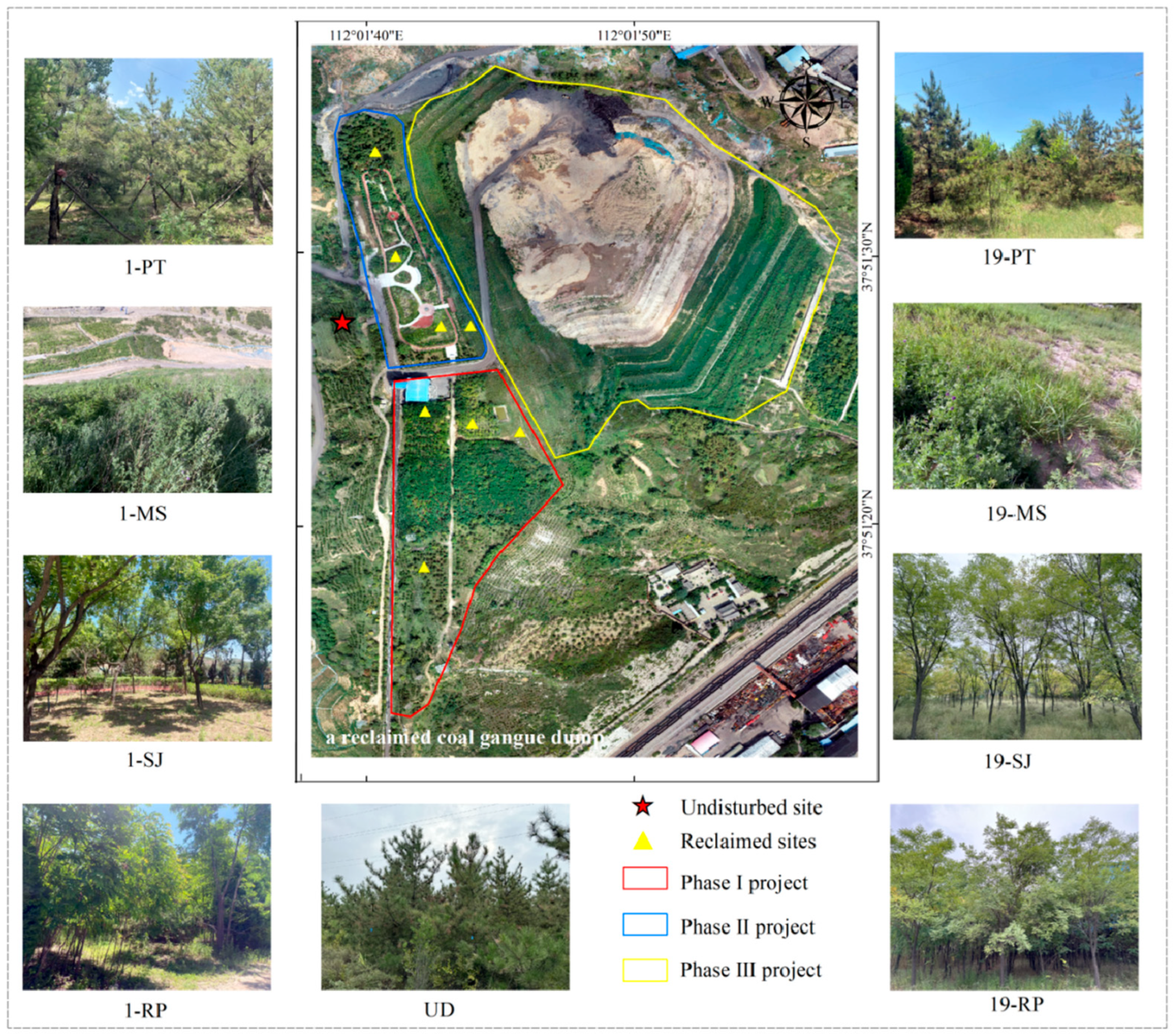
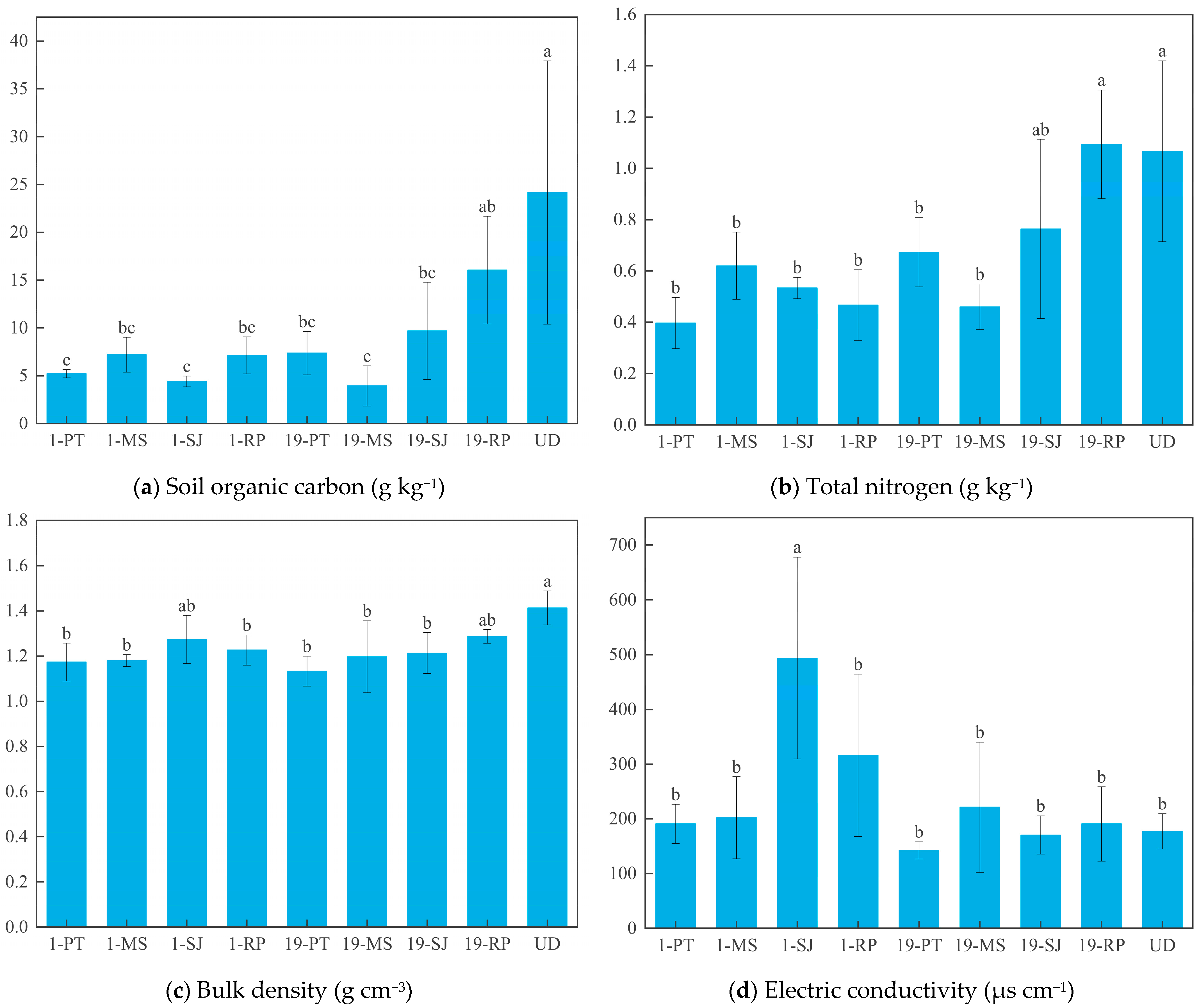
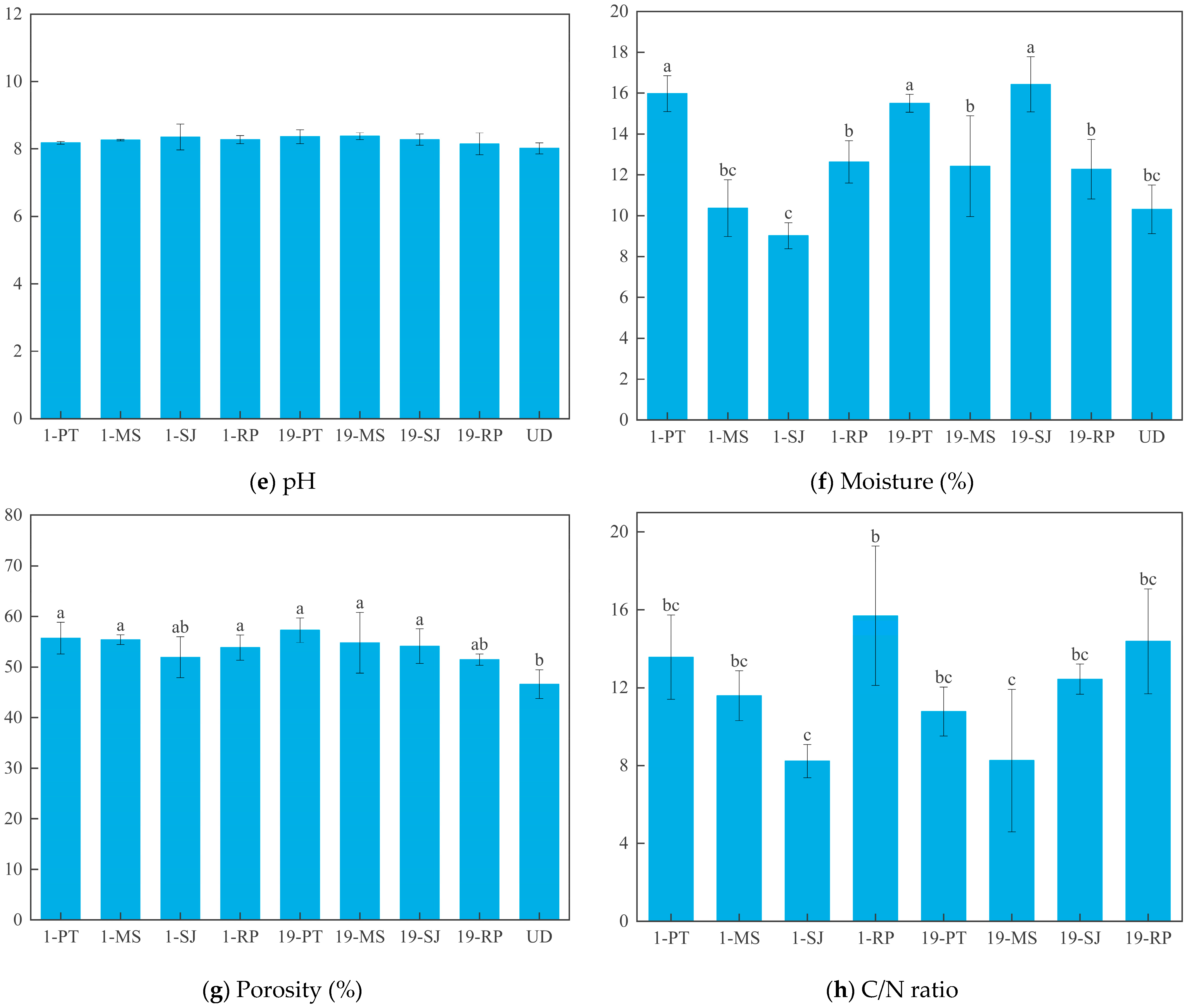
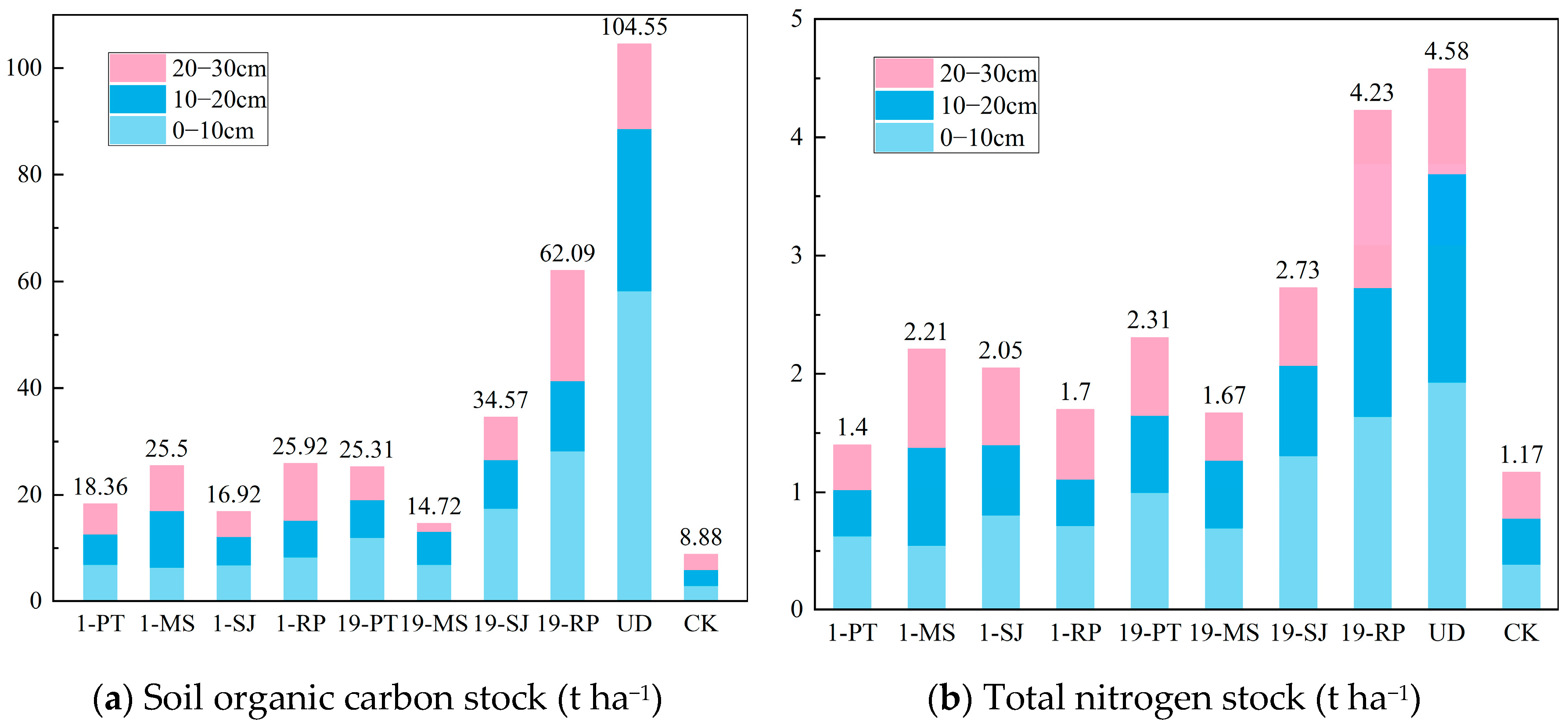
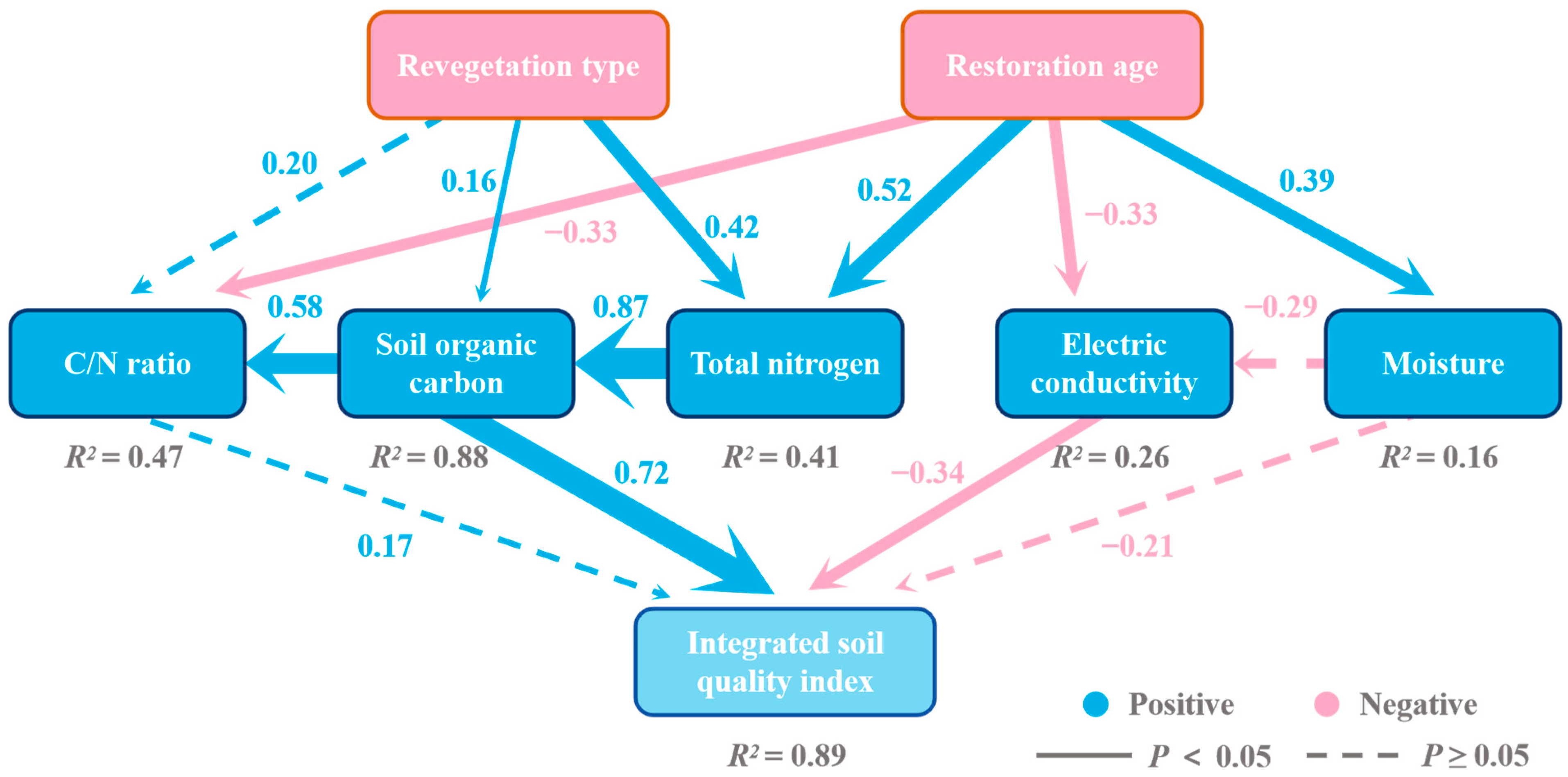
| Study Site | Dominant Species | Other Species | Tree Characteristics | |||
|---|---|---|---|---|---|---|
| Plant Spacing/Vegetation Coverage (%) | Height (m) | DBH 1 (cm) | Crown Width (m) | |||
| 1-PT | Pinus tabuliformis | - | 2.5 m × 2.5 m | 3.2 ± 1.1 | 9.98 ± 4.83 | 3.31 ± 1.83 |
| 1-MS | Medicago sativa | Amorpha fruticosa | 80% | - | - | - |
| 1-SJ | Styphnolobium japonicum | Ophiopogon japonicus | 3.0 m × 3.0 m | 4.7 ± 0.6 | 11.73 ± 2.14 | 3.10 ± 0.50 |
| 1-RP | Robinia pseudoacacia ‘Idaho’ | Chenopodium album | 0.5 m × 0.5 m | 2.7 ± 0.9 | 4.19 ± 0.91 | 1.80 ± 0.71 |
| 19-PT | Pinus tabuliformis | Syringa oblata, Leymus chinensis | 2.0 m × 2.0 m | 3.4 ± 0.8 | 10.18 ± 2.16 | 3.39 ± 0.85 |
| 19-MS | Artemisia gmelinii | Leymus chinensis, Medicago sativa | 35% | - | - | - |
| 19-SJ | Styphnolobium japonicum | Artemisia gmelinii, Leymus chinensis | 2.0 m × 2.0 m | 6.1 ± 0.5 | 13.60 ± 3.13 | 3.66 ± 0.79 |
| 19-RP | Robinia pseudoacacia ‘Idaho’ | - | 1.0 m × 1.0 m | 4.5 ± 0.9 | 4.33 ± 2.94 | 1.80 ± 0.63 |
| UD | Pinus tabuliformis | Rosa xanthina, Adenophora stricta, Artemisia gmelinii, Linaria vulgaris subsp. Chinensis, Leymus chinensis | 2.0 m × 2.0 m | 4.6 ± 0.7 | 11.71 ± 1.63 | 3.72 ± 0.32 |
| Index | Influence Factors | F | p | Eta2 |
|---|---|---|---|---|
| SOC | Revegetation species | 1.147 | 0.366 | 0.203 |
| Reclamation age | 10.181 | 0.001 ** | 0.531 | |
| Revegetation species × Reclamation age | 1.993 | 0.165 | 0.181 | |
| TN | Revegetation species | 1.485 | 0.248 | 0.248 |
| Reclamation age | 11.265 | 0.001 ** | 0.556 | |
| Revegetation species × Reclamation age | 5.708 | 0.012 * | 0.388 | |
| pH | Revegetation species | 0.559 | 0.695 | 0.111 |
| Reclamation age | 0.541 | 0.592 | 0.057 | |
| Revegetation species × Reclamation age | 0.582 | 0.569 | 0.061 | |
| EC | Revegetation species | 2.650 | 0.067 | 0.371 |
| Reclamation age | 4.943 | 0.019 * | 0.355 | |
| Revegetation species × Reclamation age | 4.742 | 0.022 * | 0.345 | |
| Moisture | Revegetation species | 10.879 | 0.000 ** | 0.707 |
| Reclamation age | 25.543 | 0.000 ** | 0.739 | |
| Revegetation species × Reclamation age | 13.489 | 0.000 ** | 0.600 | |
| BD | Revegetation species | 1.457 | 0.256 | 0.245 |
| Reclamation age | 5.713 | 0.012 * | 0.388 | |
| Revegetation species × Reclamation age | 0.731 | 0.495 | 0.075 | |
| C/N ratio | Revegetation species | 2.459 | 0.083 | 0.353 |
| Reclamation age | 4.700 | 0.023 * | 0.343 | |
| Revegetation species × Reclamation age | 2.124 | 0.149 | 0.191 |
| Correlation Coefficient | SOC | TN | pH | EC | Moisture | BD | C/N Ratio |
|---|---|---|---|---|---|---|---|
| SOC | 1.000 | ||||||
| TN | 0.864 ** | 1.000 | |||||
| pH | −0.593 ** | −0.559 ** | 1.000 | ||||
| EC | −0.193 | −0.216 | 0.350 | 1.000 | |||
| Moisture | −0.273 | −0.217 | 0.168 | −0.336 | 1.000 | ||
| BD | 0.594 ** | 0.457 * | −0.206 | 0.052 | −0.504 ** | 1.000 | |
| C/N ratio | 0.826 ** | 0.501 ** | −0.479 * | −0.168 | −0.156 | 0.548 ** | 1.000 |
| Variable | PC1 | PC2 |
|---|---|---|
| SOC | 0.924 | 0.223 |
| BD | 0.824 | −0.421 |
| Porosity | −0.824 | 0.421 |
| C/N ratio | 0.797 | 0.181 |
| TN | 0.788 | 0.280 |
| pH | −0.602 | −0.494 |
| EC | −0.149 | −0.762 |
| Moisture | −0.467 | 0.619 |
| Eigenvalue | 4.068 | 1.723 |
| Variance explained, % | 50.845 | 21.539 |
| Total variance explained, % | 50.845 | 72.384 |
| Restoration Type | Soil Layer Depth (cm) | Score | Rank | ||
|---|---|---|---|---|---|
| F1 | F2 | ISQI | |||
| 1-PT | 0–10 | −0.715 | 0.533 | −0.343 | 6 |
| 10–20 | −1.932 | 1.745 | −0.838 | ||
| 20–30 | −0.851 | 0.529 | −0.440 | ||
| 1-MS | 0–10 | −0.790 | 0.042 | −0.543 | 5 |
| 10–20 | −0.232 | −0.314 | −0.256 | ||
| 20–30 | −0.496 | −0.040 | −0.360 | ||
| 1-SJ | 0–10 | −0.093 | −4.389 | −1.372 | 9 |
| 10–20 | −1.490 | −2.370 | −1.752 | ||
| 20–30 | −0.043 | −0.891 | −0.295 | ||
| 1-RP | 0–10 | −0.001 | −0.060 | −0.019 | 4 |
| 10–20 | −0.500 | −1.515 | −0.802 | ||
| 20–30 | −0.480 | 0.114 | −0.304 | ||
| 19-PT | 0–10 | −0.059 | 1.276 | 0.339 | 7 |
| 10–20 | −2.077 | 1.175 | −1.109 | ||
| 20–30 | −2.093 | 0.982 | −1.178 | ||
| 19-MS | 0–10 | −0.529 | −0.282 | −0.456 | 8 |
| 10–20 | −0.174 | −1.402 | −0.539 | ||
| 20–30 | −3.549 | 0.368 | −2.384 | ||
| 19-SJ | 0–10 | 0.223 | 2.029 | 0.760 | 3 |
| 10–20 | −0.738 | 0.723 | −0.304 | ||
| 20–30 | −0.525 | 0.261 | −0.291 | ||
| 19-RP | 0–10 | 2.725 | 0.026 | 1.922 | 2 |
| 10–20 | 0.144 | −0.114 | 0.067 | ||
| 20–30 | 2.114 | 1.452 | 1.917 | ||
| UD | 0–10 | 6.812 | 0.298 | 4.873 | 1 |
| 10–20 | 3.721 | 0.090 | 2.641 | ||
| 20–30 | 1.629 | −0.267 | 1.065 | ||
| Construct | HTMT | Construct | HTMT |
|---|---|---|---|
| C/N ratio—ISQI | 0.573 | Revegetation age—TN | 0.480 |
| EC—ISQI | 0.413 | Revegetation age—Moisture | 0.394 |
| SOC—ISQI | 0.843 | Revegetation type—C/N ratio | 0.514 |
| TN—ISQI | 0.803 | Revegetation type—EC | 0.218 |
| Moisture—ISQI | 0.043 | Revegetation type—ISQI | 0.452 |
| Revegetation age—C/N ratio | 0.128 | Revegetation type—SOC | 0.485 |
| Revegetation age—EC | 0.441 | Revegetation type—TN | 0.374 |
| Revegetation age—ISQI | 0.269 | Revegetation type—Moisture | 0.029 |
| Revegetation age—SOC | 0.372 | - | - |
Disclaimer/Publisher’s Note: The statements, opinions and data contained in all publications are solely those of the individual author(s) and contributor(s) and not of MDPI and/or the editor(s). MDPI and/or the editor(s) disclaim responsibility for any injury to people or property resulting from any ideas, methods, instructions or products referred to in the content. |
© 2025 by the authors. Licensee MDPI, Basel, Switzerland. This article is an open access article distributed under the terms and conditions of the Creative Commons Attribution (CC BY) license (https://creativecommons.org/licenses/by/4.0/).
Share and Cite
Mou, Y.; Lu, B.; Wang, H.; Wang, X.; Sui, X.; Di, S.; Yuan, J. Evaluative Potential for Reclaimed Mine Soils Under Four Revegetation Types Using Integrated Soil Quality Index and PLS-SEM. Sustainability 2025, 17, 6130. https://doi.org/10.3390/su17136130
Mou Y, Lu B, Wang H, Wang X, Sui X, Di S, Yuan J. Evaluative Potential for Reclaimed Mine Soils Under Four Revegetation Types Using Integrated Soil Quality Index and PLS-SEM. Sustainability. 2025; 17(13):6130. https://doi.org/10.3390/su17136130
Chicago/Turabian StyleMou, Yan, Bo Lu, Haoyu Wang, Xuan Wang, Xin Sui, Shijing Di, and Jin Yuan. 2025. "Evaluative Potential for Reclaimed Mine Soils Under Four Revegetation Types Using Integrated Soil Quality Index and PLS-SEM" Sustainability 17, no. 13: 6130. https://doi.org/10.3390/su17136130
APA StyleMou, Y., Lu, B., Wang, H., Wang, X., Sui, X., Di, S., & Yuan, J. (2025). Evaluative Potential for Reclaimed Mine Soils Under Four Revegetation Types Using Integrated Soil Quality Index and PLS-SEM. Sustainability, 17(13), 6130. https://doi.org/10.3390/su17136130





